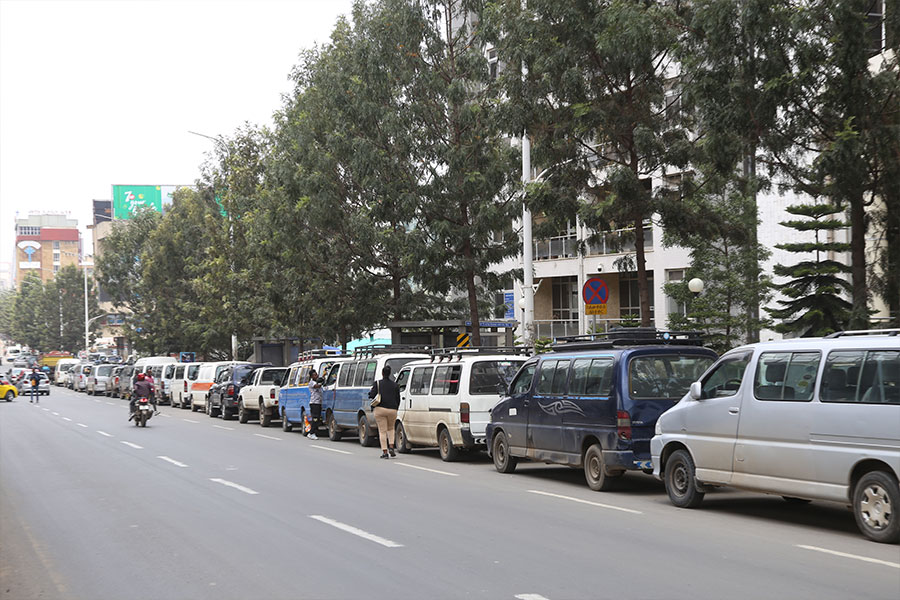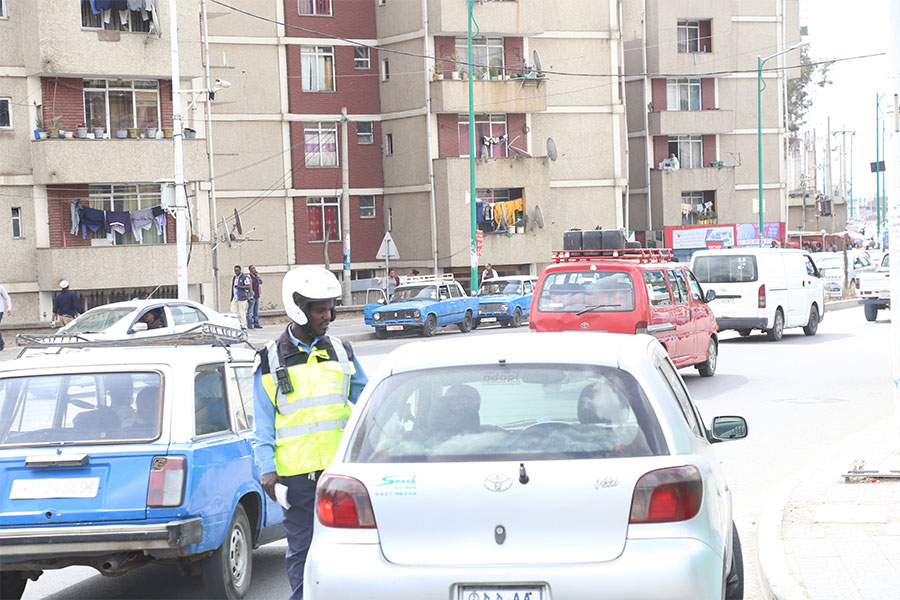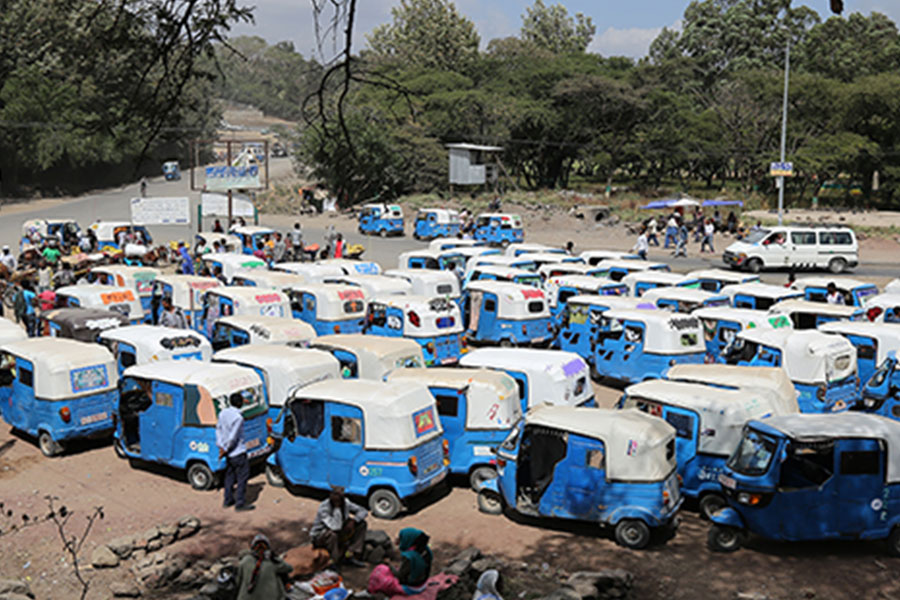
Radar | Mar 30,2019
Along Africa Avenue that leads to Bole International Airport, Deputy Inspector Abiyot Abebe and his colleagues were busy controlling the traffic flow on the road.
They randomly stopped vehicles to check for traffic regulation compliance, mainly in relation to the newly introduced safety belt regulation that forces passengers to wear seat belts as of January 12, 2020.
On January 14, 2020, the second week since the new traffic regulation was put in place, a driver of a 1998 Trios Daihatsu stepped out of the car to talk to a traffic officer about the offence he has committed related to the person in the passenger seat not wearing a seat belt.
After a short argument with the officer, the driver got back into the car, complaining about the 250 Br fine for the offence.
“Every new traffic regulation introduced makes me a guinea pig,” he complained.
Hawi Jemal, 26, was another driver fined for violating a safety belt regulation. Last week she was at Bole District Police Station to collect her driver’s license. She was one of the many drivers lined up at the station.
More than half of them were penalised for violating the new safety belt regulation. While many paid 250 Br, Hawi paid 300 Br for the same offence as it was indicated on her receipt.
“I don’t know why I had to pay more for the same traffic violation,” she said.
Hawi also argues that she should not have to pay for the passenger’s failure to wear a seat belt.
"Since my car has a functional safety belt, it should be the passenger who pays the penalty,” she said, smiling.
The Addis Abeba Traffic Commission has been working on early preparations and promotional activities for several months in advance to raise awareness about the use of safety belts before the regulation was implemented, according to Markos Tadesse, a major inspector and head of the media division at the Commission.
In the first two days after the enforcement of the new regulation, more than 6,000 drivers were penalised for the safety belt traffic violation.
In enforcing the new regulation, the Commission stated that the use of safety belts decreased the number of deaths related to traffic accidents by half for those passengers in the front seats.
law enforcement officers on the streets of Addis are on the lookout for drivers failing to comply with the latest safety belt regulations fully enforced since January 12, 2020.
Traffic accidents are becoming a nightmare in the country, taking the lives of many. In Addis Abeba, traffic-related deaths went up by one percent as serious injuries increased by a fifth in the first quarter of the current fiscal year.
The death rate has also increased by a third in Oromia Regional State from the same period last year with 433 people perishing in 1,095 traffic-related accidents. Close to 618 car accidents claimed the lives of 183 people in the Amhara region in the same period this year.
Nationally, the number of accidents occurring last year stood at 40,871 with 4,597 deaths; additionally, 7,408 and 5,949 people sustained serious and minor physical injuries, respectively. The associated property damage was estimated at 872.9 million Br.
A recent study conducted by the Bloomberg Initiative highlighted the poor utilisation of safety belts in Ethiopia despite encouraging improvements made in other areas including helmet use, speed control and drunk driving.
Globally, out of the 1.2 million traffic accidents, 45pc caused serious injuries to passengers that could have been prevented or minimised by the mere use of a safety belt.
The use of safety belts decreases the number of deaths related to traffic accidents by 45 to 50pc for those passengers in the front seats, while it reduces the death rate of passengers in the back seats by 25pc to 35pc, according to WHO.
During the first quarter of this fiscal year, 43 deaths and 101 serious injuries were reported related to traffic accidents in the capital city alone.
Concerned with the ever-growing traffic accidents that claim the lives of drivers and passengers, the Federal Transport Authority has introduced the new safety belt regulation that makes wearing seat belts mandatory for passengers in all types of vehicles.
It was introduced based on an earlier proclamation revised in 2017 that declares it is the responsibility of drivers to ensure the safety of all passengers on board, including verifying that they are wearing seat belts.
The proclamation declares all passengers in all types of vehicles traveling a distance of more than 150Km out of a city, while it gives room for qualified enforcement based on the types of vehicles used within the boundaries of a city.
Accordingly, all vehicles having five to eight seats are required to comply with safety belt requirements for all passengers. Public transport vehicles having between 12 and 25 seats traveling within the distance limit indicated for the inner city are required to enforce safety belt compliance on the front seat passengers only.
Passengers in the back seats are advised but not obligated unless they are traveling over 150Km outside the city, according to Yigzaw Dagnew, communications affairs director at the Authority.
The traffic regulations now in place have different levels of fines and penalty points that can be registered on driver's records depending on the seriousness of the violations.
In the first two days after the enforcement of the new regulation, more than 6,000 drivers were penalised for the safety belt traffic violation.
Penalty points are not recorded on drivers files for the first level traffic offences, but it holds a fine of 100 Br. The second and third levels have one and two penalty points, while the fourth and fifth levels have three and four penalty points, respectively, in addition to payment of fines up to 350 Br.
The safety belt regulation lies in the level four category that entails three penalty points in addition to the 250 Br fine.
Wuletaw Amsalu, 42, who drives a 2002 model minibus taxi, was also fined for failing to enforce the seat belt regulation on a front seat passenger.
“Since it was a short distance," said Wuletaw, "I didn’t think it was that important to make sure the passenger on board had the safety belt on.”
Wuletaw generally accepts the importance of the safety belt regulation, but he still has reservations.
"Though it is quite useful for those driving long distances outside the city,” said Wuletaw, "I don’t think it is that important for vehicles commuting within the city."
Habtamu Mezgebu, also 42, shares Wuletaw’s view.
“I don’t think it is practically convenient for taxis like ours,” said Habtamu, who drives a 1984 model minibus taxi, which is visibly in poor condition.
One of the passengers’ seats at the front has a safety belt but not the one in the middle. Hence, he folded the middle seat and kept it out of service to avoid the vigilant eyes of the traffic police on the streets.
“Seat belts of such old vehicles break down, as they can't sustain the frequent rotation of passengers who usually travel short distances,” he remarked.
Some minibus taxis appear to comply with the regulation by keeping the middle front seat out of service, at least for the time being. But others still dare to take their chances while the officers are not in sight.
Some minibuses keep the seat belt to show a visible sign of compliance to the law enforcement officers, but if one pulls it hard just to check its functionality, it is apparent that it does not hold back the passenger fastened to the seat during an emergency.
Biniyam Getachew, director of traffic control and event administration at the Addis Abeba Drivers & Vehicles Licensing & Control Authority, argues that it should indeed be the responsibility of the drivers to ensure that all the passengers wear safety belts during commutes.
“Passengers get on board because they trust the competence of the driver who should also ensure the technical conditions of the vehicle they are driving,” he said. “Therefore, it is logical that it is the driver’s responsibility to ensure compliance, and thus they should be penalised for failure to do so.”
Though the fine rate is fixed, some drivers like Hawi are fined more than the regulated rate.
This discrepancy happens due to a calendar system used by the traffic police officers and payment system at the banks. Traffic police use the Julian calendar, while the banks use the Gregorian calendar, according to Biniyam.
The new penalty payment system imposes an additional penalty of five percent a day if the penalty is not settled within the first ten days.
"So, if the bank clerks don't properly convert the local calendar into the Gregorian one,” Biniyam said. "The five percent payment will be calculated on the date difference occurring at conversion."
“We've corrected such errors in relation to penalty payments to avoid such inconsistencies,” Biniyam noted.
The other reason for the variations in the payment rates is related to earlier penalty records that were not settled on time. The current penalty payment takes into account any outstanding penalty records of a driver that has not been settled before.
The latest traffic regulation also made certain amendments to the previous version in terms of reducing the validity period of penalty points on driver's records from two years to a year. It also excluded 24 types of minor traffic offences drivers usually commit out of the penalty point recording system.
Drivers with accumulated penalty points of 19 and above will be suspended for a one-year period. Traffic accidents resulting in death carry 28 penalty points and accidents causing serious physical injuries entail 22 penalty points. In both situations, the driving license of the driver responsible for the accidents is suspended for up to one year.
While concerning many drivers and vehicle owners, the new regulation opened a business opportunity for some retailers of spare parts.
Hekniem Minas, a salesperson at Jemila Auto Body Parts in Teklehaimanot area, is one of them who is currently visited by many who look for seat belts.
“Before the introduction of the new regulation," said Hekniem, "no one came to our shop to ask for a safety belt."
The prices of the safety belts shot up to well over 900 Br in the few shops that provide the belts. Previously, they were sold for less than 400 Br.
Hekniem currently sells the safety belts for 600 Br.
PUBLISHED ON
Jan 25,2020 [ VOL
20 , NO
1030]

Radar | Mar 30,2019

Fortune News | Jul 02,2022

Radar | May 13,2023

Fortune News | Jul 07,2024

Fortune News | Aug 07,2021

Fortune News | Nov 27,2021

Fortune News | Apr 29,2023

Fortune News | Aug 27,2022

Fortune News | Dec 08,2024

Fortune News | Oct 30,2022

Dec 22 , 2024 . By TIZITA SHEWAFERAW
Charged with transforming colossal state-owned enterprises into modern and competitiv...

Aug 18 , 2024 . By AKSAH ITALO
Although predictable Yonas Zerihun's job in the ride-hailing service is not immune to...

Jul 28 , 2024 . By TIZITA SHEWAFERAW
Unhabitual, perhaps too many, Samuel Gebreyohannes, 38, used to occasionally enjoy a couple of beers at breakfast. However, he recently swit...

Jul 13 , 2024 . By AKSAH ITALO
Investors who rely on tractors, trucks, and field vehicles for commuting, transporting commodities, and f...

Jul 12 , 2025
Political leaders and their policy advisors often promise great leaps forward, yet th...

Jul 5 , 2025
Six years ago, Ethiopia was the darling of international liberal commentators. A year...

Jun 28 , 2025
Meseret Damtie, the assertive auditor general, has never been shy about naming names...

Jun 21 , 2025
A well-worn adage says, “Budget is not destiny, but it is direction.” Examining t...